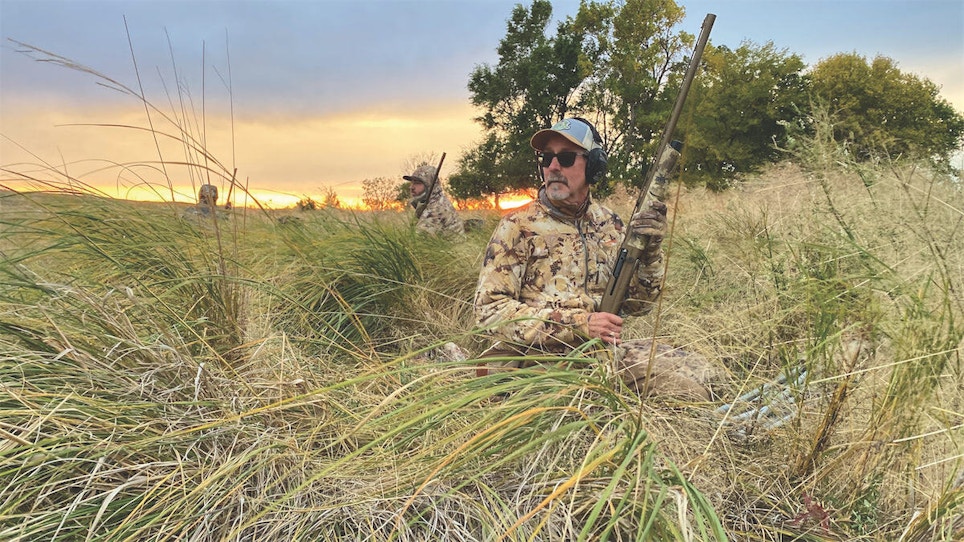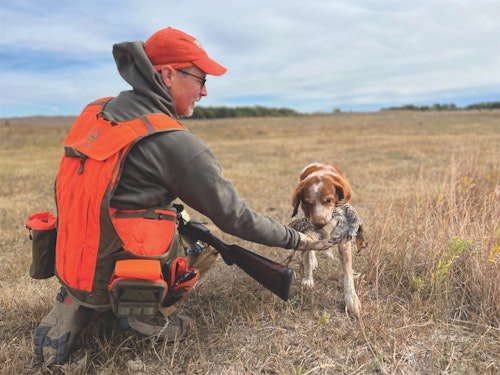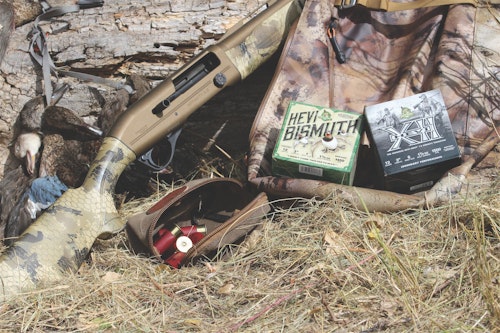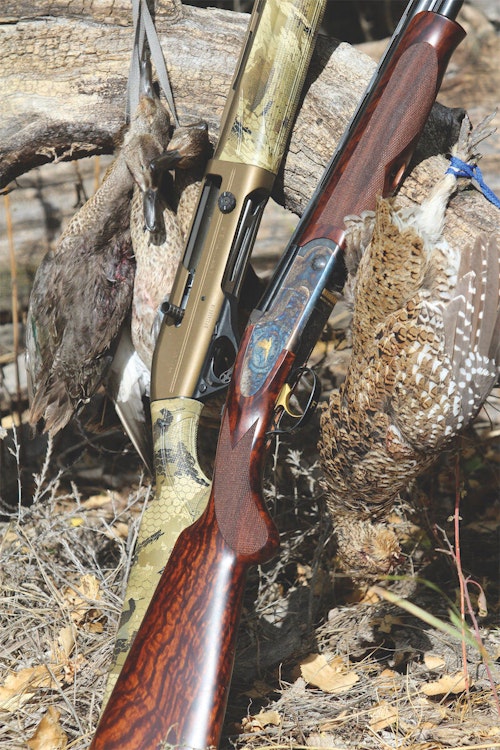It’s one of my favorite hunting destinations — the Nebraska Sandhills. Over the years, I’ve traveled there to hunt many of the hardy creatures that eke out an existence on this expansive landscape — mule deer, whitetails, coyotes, turkeys and those feathered upland fowl that inhabit this grasslands ecosystem. This protein-rich smorgasbord provided sustenance for frontiersmen and their families as they traversed the Great Plains during the mid-1800s, and today it draws sportsmen who enjoy pursuing a mixed bag.
October’s Hunter’s Moon lit the southwestern sky like a guiding beacon when I pulled out of my driveway and pointed the FJ Cruiser toward the Cornhusker State. My destination was a drop camp near Elsmere, a tiny rural town located between North Platte and Valentine in Cherry County. To give you an idea of just how rural it is, the entire population of Cherry County is roughly 5,500 souls, and Elsmere fails to register on many road maps.
The hunt was the collaborative effort of Joe Arterburn/Arterburn Outdoors and Scott Fink, owner of Goose Creek Outfitters (www.goosecreekoutfitters.com) — designed to give a handful of hunters a taste of what the prairie region has to offer in terms of upland/waterfowl hunting. For me, this was a homecoming of sorts because I’ve known Joe for decades and hunted whitetails with Scott just a few years back. Joe would provide the living quarters — a cluster of canvas that made up the uber-comfortable camp — and Scott the prime hunting property. This time we’d be after feathered fare — homegrown prairie chickens and transient ducks.
The greater prairie chicken once occupied most of North America’s mid-section — stretching from the Canadian prairie provinces south as far as Texas and east throughout the Great Lakes states. Today, remnant populations occupy parts of the Dakotas, Nebraska and Kansas with strongholds in some localities where habitat best suits and supports them, with Scott’s property at the epicenter. The vast majority of Nebraska’s annual duck migration passes through the state via the massive Central Waterfowl Flyway from the Prairie Pothole Region — the Dakotas and points north — lingering on the North Platte River and prairie potholes that dot the landscape.
This surf-and-turf combo creates a perfect storm for sportsmen who wish to get the biggest bang for their buck by hunting a mixed bag — a narrow window of opportunity when both populations are at their peak for the year. Family coveys of grouse provide a great workout for hunters who aren’t afraid to burn some shoe leather and ducks of numerous species pass through the region in great numbers on their way to their southern wintering grounds.
Nebraska did not disappoint, but it didn’t give up its treasures easily either.
Battling Wind
We woke to cool temps the first morning with winds gusting to well over 40 mph. As we fanned out for our first push to the horizon, it was all I could do to keep my cap on my head. My Brittanys — Rebel and Riot — quartered wide, trying to pick up scent in the blustery conditions. Back at the truck we looked like a beaten lot — a couple bumped birds, but no shots fired. No one said it, but I’m pretty sure everyone was thinking it was a waste of time and energy.
As we were considering our limited options, Scott pulled up in his truck and our jaws dropped as he reached into its bed and proudly hoisted a pair of grouse. “Shot ’em in the pasture behind the house,” he beamed. That gave us the inspiration to get back at it, and while I’d like to say we slayed them that afternoon, we didn’t. But we did end up with a handful of hard-earned grouse that turned a dismal day into a delightful one.
The wind was just as bad the next day, and we decided to give waterfowl a try. We split into two groups and hiked a half-mile or so to a string of potholes. Our group of four had only a handful of decoys, and we deployed them along the downwind shore. If you think teal fly fast — and they do — try getting the lead on one in a 40-plus mph wind. But once we got that figured out ducks began to fall. In the three hours we spent there, we killed 14 ducks, mostly teal. Not a bad day, considering the conditions.
Gear Consolidation
Hunting a mixed bag of fowl seldom requires two completely different sets of equipment, but it does mean some refinement might be needed to achieve optimum efficiency. In the case of this upland/waterfowl hunt, two different shotguns were employed to better match field conditions and quarry. Same for ammo and even boot selection. Consolidation came in the form of our camo clothing and the drop camp hunting headquarters, which was proximate to both the grasslands where we hunted grouse and the prairie potholes where we ambushed ducks.
Here’s a breakdown of the gear I used for this hunt. Shooting sports retailers take note: When outfitting your customers for a multi-species hunt, make sure they have the proper gear to cover all the bases while consolidating where possible. And remember, if they’re flying to their hunting destination it becomes more important to consolidate wherever possible — to zero-in on equipment that is essential and reject that which is not.
Guns and Ammo
There are no one-size-fits-all solutions when it comes to shotguns. Today’s scattergun enthusiast is a specialist who demands that his firearm specifically matches the purpose at hand. And for good reason. The heavy 12-gauge autoloader that serves the hunter well in the duck blind, for example, might become cumbersome when covering miles of prairie on foot in search of grouse. Here, a lightweight over/under might be a better choice. For this hunt I settled on a pair of 12-gauge beauties from Italian gunmaker Franchi — the Affinity 3.5 Waterfowl Elite autoloader for waterfowl and Instinct SL over/under for grouse.
When pursuing prairie grouse, hunters spend a lot more time walking than shooting — slowly lulled to complacency only to have a covey erupt at their feet. And that’s why a quick-handling lightweight shotgun such as the Instinct SL is an excellent choice. To prevent fatigue and ensure day-long comfort it is ergonomically designed around an aluminum receiver to provide exceptional fit, balance, feel and portability in all upland environments. A distinct, scalloped receiver teams perfectly with a stained A-grade satin walnut stock for a sleek look.
The gun’s underside features a Franchi logo and classic, subtle engraving and its slim, purposefully designed Prince of Wales grip with cut checkering combines superior ergonomics and shooting comfort with traditional style. A slim and tapered forend features cut checkering for heightened performance. Standard features include automatic ejectors, horizontal barrel selector switch on the tang-mounted safety, three extended choke tubes, vented rib and fiber-optic front sight. The Instinct SL is available in 12-, 16-, 20- and 28-gauge as well as .410-bore.
As efficient as this classy over-under is in the upland arena, it’s a poor match for the duck blind, where a third shot can be a godsend. That, and the need for a camo finish, is why the Affinity 3.5 Waterfowl Elite was a better choice.
The Affinity 3.5 Waterfowl Elite 12-gauge inertia-driven autoloading shotgun was designed from the ground up to provide optimal comfort in any shooting position, with its sleek profile, slim forend and integrated ergonomics. It has a weather-resistant Cerakote finished chrome-lined barrel, Franchi Precision Cones for improved shot patterns and Truglo dual-color fiber-optic sights for fast target acquisition, even in low-light conditions. The stock is adjustable for drop and cast to ensure a great fit and a TSA recoil pad dramatically reduces felt recoil. A wide loading port, along with a Sure Cycle large bolt release and oversized bolt handle accommodate hunters wearing gloves in inclement weather. Chambered for 2.75-, 3- and 3.5-inch shotshells, it comes dressed in Gore Optifade Waterfowl Marsh camo.
As a shooting sports retailer, it’s up to you to help your customers make wise purchase decisions by engaging them about the intended use of any firearm they are considering and then directing them to specific models that will best fit the application. But the sales pitch shouldn’t stop there. No shotgun-buying customer should leave your store without a proper education on shotshells and their specific applications. There is no one-size-fits-all solution when it comes to scattergun ammunition either.
For our hunt we used HEVI-Shot loads for both grouse and ducks. Over the past two decades, HEVI-Shot has become an industry leader in creating high-performance, non-lead shotshells for all types of hunting — its original goal to create waterfowl ammo that outperforms steel. To do this, they spent more than a year developing their own alloy mixture using tungsten and other metals. The result was a very heavy pellet that is far superior to steel, but also outperforms lead due to its amazing density. Along the way, HEVI-Shot also started crafting its own bismuth pellets.
In February 2021, Vista Outdoor purchased HEVI-Shot. This is the same company that owns Federal Premium, Speer/CCI and Remington Ammunition. Overnight, HEVI-Shot had access to quality resources with hundreds of years of factory experience making ammo to back them. HEVI-Shot’s factory and American workforce is in Sweet Home, Oregon.
HEVI-Shot’s new HEVI-XII tungsten waterfowl loads, weighing in at 12g/cc, produce patterns that are 53.8% denser than steel. What that means to waterfowl hunters is that they can now shoot loads that are three shot sizes smaller than steel and put 28% more pellets on target that penetrate deeper because of their smaller size. HEVI-XII loads have muzzle velocities between 1,350 and 1,500 fps and are available in 12- and 20-gauge with .875-ounce, 1-ounce, 1.125-ounce and 1.25-ounce loads of Nos. 2, 4 and 6 shot.
HEVI-Bismuth hits both upland game birds and waterfowl with the devastating power of 9.6g/cc density pellets — 22% denser than steel. Launched by the rear deploying Flitecontrol Flex wad, bismuth pellets pattern consistently, and their metallic properties make them safe in both modern and classic shotguns.
Dressed to Kill
We experienced yo-yo temperatures during the hunt — ranging from the low 20s to the mid-80s — and layering for comfort and efficiency was the name of the game. The Sitka Gear garments we employed worked well while pursuing grouse and served double duty in the duck blind in that full range of temperatures.
Sitka Grinder pants were designed to stand up to the rigors of waterfowl hunting but were also a good fit for hunting grouse, built with lightweight four-way stretch nylon fabric. These pants provided an enhanced range of motion for all day comfort whether we were on the move or setting up an ambush.
Upper garments were cloaked in Sitka’s Optifade Waterfowl Marsh pattern — Grinder Zip-T top, Icon Pullover Hoody, Ambient Jacket and Jetstream Jacket. This provided the opportunity to mix and match clothing for changing conditions. The Grinder Zip-T and Icon Hoody provided the mid-layers — the Grinder Half-Zip worn between a next-to-skin layer and the Icon hoody or as a breathable, water and abrasion-resistant outer layer. The Icon Pullover Hoody added a layer of cozy, made from a cotton poly blend for long-lasting comfort.
Ambient and Jetstream jackets provided a weather stopping outer layer. Sitka’s Ambient jacket was engineered to adapt to changing weather conditions and levels of activity. When users are static and temperatures are low, it insulates to deliver warmth. When wearers are active or temperatures rise, it breathes well to expel heat. When the mercury took a nosedive and the winds kicked up to 40 mph, the Jetstream jacket provided the last line of defense. Built to retain warmth yet breathe when needed, this workhorse softshell jacket with comfortable micro-grid fleece backer offers the utmost versatility.
Creature Comforts
An outfitter once told me that while he could not manage aspects of the hunt such as weather, travel difficulties and animal behavior, it is important that he controls the controllables. If he did that — and gave his clients a fighting chance at filling their tags — he had done his job. And that means keeping hunters warm and dry and providing high-quality food and drink and a good night’s sleep.
For our hunt, comfortable, well-designed canvas tents from White Duck Outdoors — built with its proprietary Dynaduck fabric — provided supreme slumber. All canvas tents from White Duck Outdoors come with a built-in stove jack, storm windows, premium bug mesh on the doors and windows and pocket organizers at no additional cost. They arrive outdoors-ready, with all the poles, angle kits, stakes and pins, guy lines and a tool kit included. White Duck Outdoors offers a complete range of canvas tents, which include wall tents, bell tents and canvas cabin tents — available in a variety of sizes.
Brooks Hansen, Marketing Communications Manager for Camp Chef served as camp cook, putting the company’s top of the line cooking tools to work. He proved that cooking skills and the proper implements can turn freshly killed game into mouth-watering morsels with the flip of a spatula. As a shooting sports retailer, you have the power to provide those accouterments needed to turn freshly field dressed game into exquisite table fare. Here, the folks at Camp Chef have you covered — pellet grills, flat top grills, cast iron cookery, propane grills and smokers and all the accessories primed for cross-selling that major purchase — seasonings, charcoal pellets and starters, cleaning tools and supplies, grilling utensils and such.










